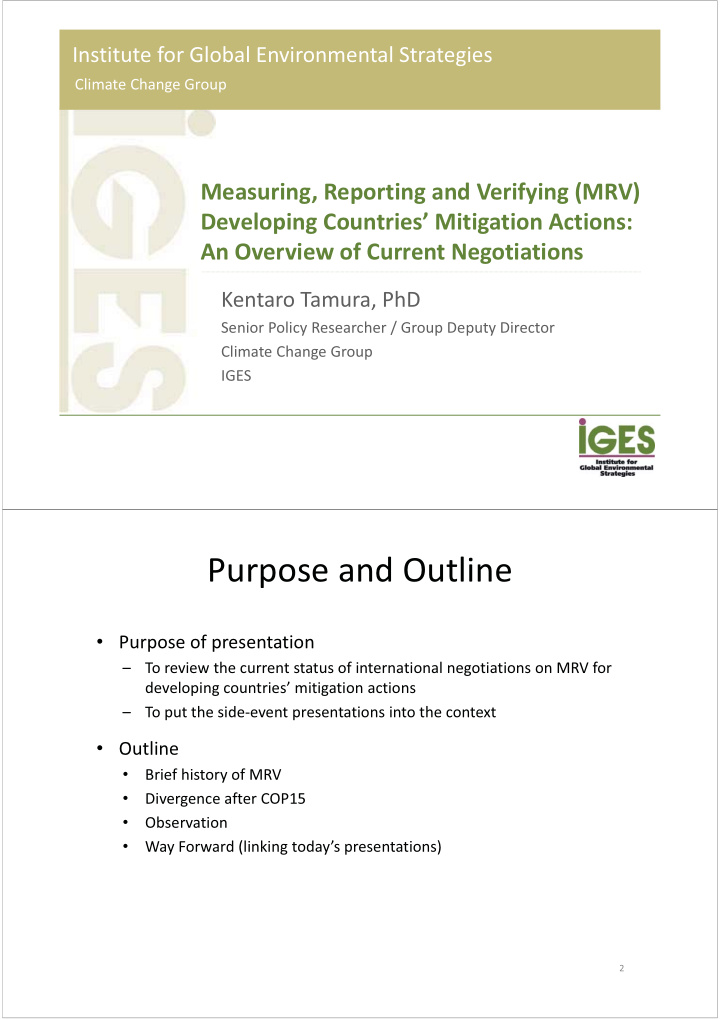



Institute for Global Environmental Strategies Climate Change Group Measuring, Reporting and Verifying (MRV) Developing Countries’ Mitigation Actions: An Overview of Current Negotiations Kentaro Tamura, PhD Senior Policy Researcher / Group Deputy Director Climate Change Group IGES Purpose and Outline • Purpose of presentation – To review the current status of international negotiations on MRV for developing countries’ mitigation actions – To put the side-event presentations into the context • Outline Brief history of MRV • Divergence after COP15 • Observation • Way Forward (linking today’s presentations) • 2
Brief History of MRV • Transparency • Accountability MRV • Equity/Comparability • Efficiency BAP 1(b)i BAP 1(b)ii Developed countries Developing countries Support Nationally appropriate Nationally appropriate Technology, financing mitigation commitments or mitigation actions supported and capacity-building actions and enabled (by support) CHA para 4 CHA para 5 CHA para 4 Delivery of financing • (Unsupported) mitigation actions Quantified economy-wide by developed � domestic MRV emissions targets for 2020 countries • Results of implementation � biennial NATCOM with provisions for Int’l Analysis and Consultation (ICA) • NAMAs seeking int’l support � registry • Supported NAMAs � int’l MRV 3 Divergence after COP15: Two Fundamental Questions • Should mitigation actions by developing countries, whether supported or unsupported, undergo some form of MRV? – Some Parties put the negotiation text’s paragraphs related to MRV/ICA in brackets. – Others support the language of CHA. – Others propose more concrete framework for MRV/ICA. – The split of views does not fall along developing and developed country lines. • What are NAMAs and “mitigation actions” concerned? – Negotiation Text (FCCC/AWGLCA/2010/14) � no consensus • […voluntarily] undertake nationally appropriate mitigation actions [(NAMAs)] [REDD programme], enabled and supported by finance, technology and capacity building… • [Nationally appropriate] [M][m]itigation actions supported by …. • …[voluntary] domestically funded [nationally appropriate] mitigation actions… – What are relations between NAMAs and those actions listed in the Appendix II of the Copenhagen Accord? 4
Divergence after COP15: MRV Process Int’l MRV Some parties argue that supported NAMAs shall not be subject to int’l MRV. • Majority of Parties favour int’l MRV of supported NAMAs • – What should be measured, and how? – What kind of information should be reported, by which media, and how often? – Who should verify? – What is the role/function of registry in MRV? Domestic MRV Some Parities put the paragraph related to domestic MRV in brackets. • Majority of Parties favour domestic MRV of domestically-funded • mitigation actions. But, to what extent should domestic MRV follow international rules? – Need to address elements which are requested to report biennially – Verification: Reviewers meeting int’l standards of independence – With provisions for facilitative ICA 5 Divergence after COP15: ICA Process • Proposed process for ICA (Negotiating Text, para. 41-43) Int’l consultation Int’l analysis – Who conducts? – By what form? Independent panel of experts Exchange of views under SBI � representing all regions � Among Parties � rotating experts selected � Between Parties and experts – What to analyse? – What to consider? � Correct application of � Pledges and implemented actions methodologies � Emissions trends � Implementation status � Areas for capacity building � Effectiveness – What would be outcome? – How to conduct? � Technical recommendations � In-country visit � Identification of areas for � Mtg. with Party representatives improvement � Policy recommendations, if 6 requested
Observation • Step-back from the Copenhagen Accord – Developed country Parties made detailed proposals for MRV/ICA procedures, while being largely silent about MRV for their commitments (mitigation and support). – Some developing country Parties fiercely reacted to such proposals. – Some Parties tried to ignore the Copenhagen Accord, while others favour building upon the Accord. � Mutual distrust � Erosion of constructive atmosphere 7 Way Forward • More balanced discussion on MRV issues – MRV for developed countries’ commitments and actions (mitigation and finance) – MRV for developing countries’ mitigation actions • For MRV of developing countries’ mitigation actions to be effectively designed, it is important to: – Improve understanding of the existing domestic monitoring, reporting and evaluating procedures in developing countries – Improve understanding of the contents and characteristics of mitigation actions by developing countries • Mr Fukuda’s presentation will look at actual pledges listed in Appendix II of the Copenhagen Accord. – Examine lessons learnt from international processes, such as CDM and other treaties • Dr Mizuno’s presentation will focus on MRV in CDM. 8
Recommend
More recommend